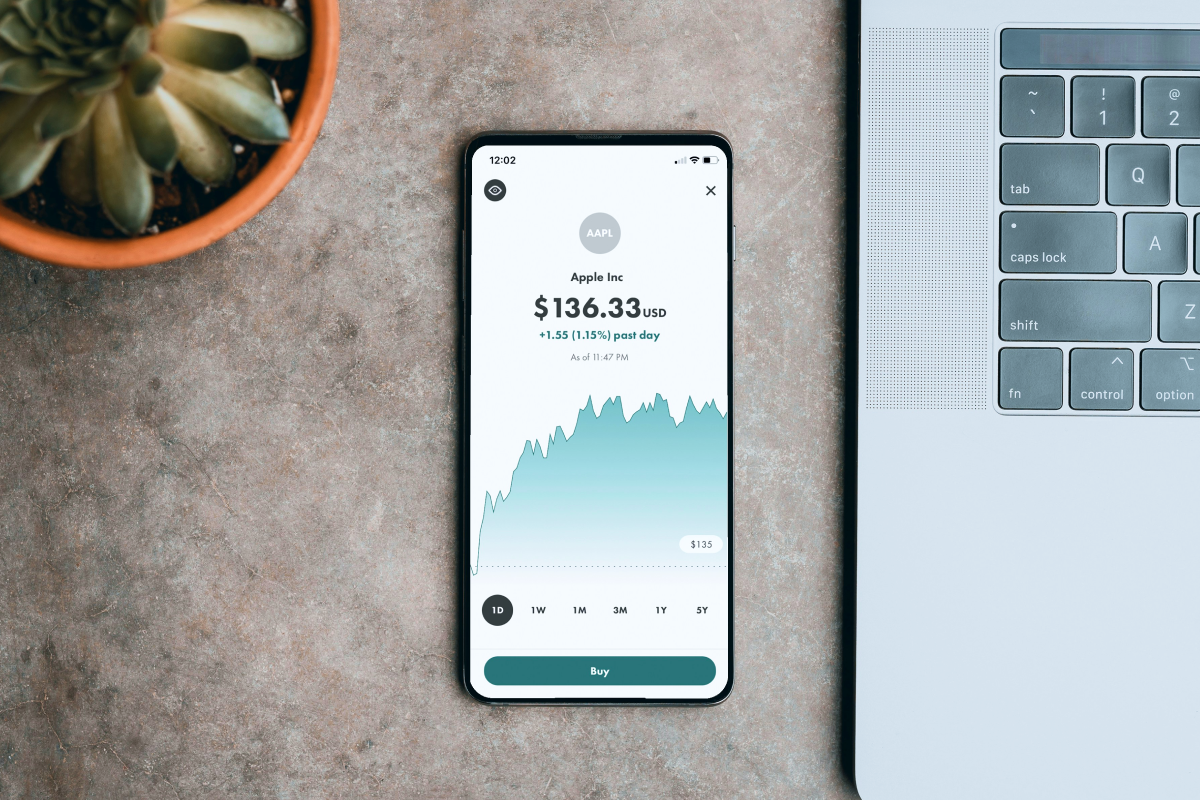Fintech is booming as more consumers turn online for their banking and financial needs. As founders or CTOs, there’s no better time to capitalize on the growing trend of mobile banking. After all, the global market fintech market is predicted to hit $1.15 billion by 2032, compared to $294.74 billion in 2023.
However, before you jump on the fintech bandwagon, you’ll need to put a number to the fintech app development cost. Unfortunately, determining the cost to develop a fintech app isn’t straightforward. There isn’t a fixed number. Instead, you’ll need to consider several factors.
But worry not. I, Yan Likarenko, will help you out. For years, I’ve been Uptech’s Product Manager and assisted clients, including startups and SMBs in planning out their development budgets. In this guide, I’ll show you factors that determine the cost to build a fintech app. More importantly, we’ll explore ways to optimize your cost without compromising quality, security, and compliance.
Let’s start.

So What Makes Up The Fintech Development Costs?
As mentioned, the cost of developing a fintech app depends on several factors. Even if we’re building seemingly identical apps, one might be more expensive than the other. But why?
Well, as you read on, you’ll figure out how fintech development costs are influenced by factors like the team you hire, app complexity, design requirements, and more.

The development team
To develop a fintech app, you need a team of app developers, designers, QA engineers, project managers, and other supporting roles. However, depending on the hiring mode, the fee you pay might be more or less.
In-house hiring
At a glance, hiring an internal team seems to be the most cost-friendly option. Plus, having a long-term permanent team provides the stability that SMBs seek. However, be mindful of long-term commitments that might stretch your operating budget.
Let’s say you hire a fintech developer to build your product. Besides paying their salary, you’ll also need to commit to their insurance, perks, training, and other mandatory benefits. Plus, you’ll need to sustain your in-house team after they’ve finished the project.
Outsourcing
Usually, startups aren’t financially prepared for in-house hiring, which brings us to the next option — IT outsourcing. Here, you engage an independent contractor that provides financial development services. Rather than paying fixed expenses, you work out a collaboration model, such as time and material or a dedicated team.
With outsourcing, you pay only for the time or services rendered. The beauty of this option is that it frees you from having to personally manage the developers. As the contracted agency takes control of the development, you can focus on other aspects of your business.
Outstaffing
Outstaffing is similar to outsourcing, except that you take full control of the remote developers an external agency hires. When you outstaff, the contracted agency will recruit and onboard a team of developers on your behalf. Then, you assimilate the external team with your internal one.
Many SMBs choose to outstaff because they can retain full control of the development process without committing to more hiring. In a way, outstaffing helps you balance stability with financial commitments.
Location of the development team
Besides who you hire, where you hire from also matters. Like it or not, the fee to build a fintech app is directly affected by the location from which your developers work.
If they’re based in cities with high costs of living, like New York, London, or Los Angeles, you pay more when contracting them. Likewise, you pay a lower fee if the development team operates in countries like India, China, the Philippines, and Ukraine.
For example, fintech developers in the US charge $100 - $150 per hour, but those based in India charge only $20 -$50. Instinctively, founders would want to opt for the cheapest developers, but we strongly advise you to consider different factors, like expertise in your industry, specific technologies, programming languages, portfolio, timezone, and communication.
For example, Ukrainian developers charge around $50 per hour. For that fee, you enjoy quality work and significant savings.
We have a dedicated article on offshore software development rates in different regions. Check it out to get precise numbers and a bigger picture.
App complexity
Another major cost factor is the app itself. A simple fintech app requiring only basic features like user login, account management, and spending tracker will cost less to build. That’s because developers can spend less time and effort to complete the entire project.
On the other hand, be prepared to pay more if your app requires complex features. For example, a blockchain-powered investment app is considerably more difficult to build. You’ll need to hire specialized talents, such as AI experts, blockchain developers, and financial analysts, when building the app.
Be mindful that every feature, be it complex or not, might require work to be performed for frontend, backend, UI/UX, and QA tests. And those add up to the final cost. Also, because fintech is a tightly regulated industry, you’ll also need to allocate a budget to meet compliance requirements, such as PCI-DSS, GDPR, and other financial regulations.
Number of integrations
Most fintech apps require third-party services to function. For example, if you build a banking app like Chime, you’ll need to integrate with payment gateways, traditional bank services, and KYC checks. Likewise, an investment app may require AI integration to provide forecasting and support real-time cross-border transactions, respectively.
As a rule of thumb, the more integrations you have in your app, the higher the fintech app development cost will be. And that would send some CTOs and founders thinking — would they save more if they build those services from scratch instead?
Well, if you decide to develop the payment gateway, AI predictive model, or other technologies on your own, you’ll end up paying more. On top of that, you also face a huge opportunity cost as it takes much longer to get your product to the market.
Rather, it’s better to choose the right integrations for cost and efficiency. For example, you can integrate open banking API to exchange financial data safely with banks instead of building the entire data pipeline.
Design Complexity
One of the most common fintech startup mistakes is releasing an app that falls short of user expectations. If your app fails to engage the users, it’s only a matter of time before they quit for a competitor. Hence, it’s crucial to focus on the app’s UI/UX despite paying more.
A simple app requiring basic interfaces and a straightforward customer journey takes less time to build and is cheaper. Conversely, fintech apps that require custom animations, heavy interactions, and complex customer journey maps will cost companies more time and money.
Cost Breakdown for Fintech App Development
While we can’t provide an exact figure, we can give you a fintech development app estimate for each stage. Below is a typical software development process we follow at Uptech. We’ll explain what transpires in each and the cost they incur.

Pre-development phase
The first thing we do before starting the development is – map out all the activities that need to get done. This helps us and our clients understand where we will spend most of our time and resources.
Planning & Discovery
Before we create a fintech app, we need to ensure that it will eventually be purposeful. In other words, the app should solve a real problem. To find out, we conduct the discovery phase, where we interview and collect feedback from the target audience.
From the findings, we decided which tech stack, integrations, skills, and other resources were needed. Also, we determine the fintech security and compliance requirements to make the appropriate provisions, such as GDPR, PCI-DSS, and KYC. Then, our team advises the client on the estimated timeline and important milestones.

For example, when we took on a green investment app development project, we realized that the target audience was quite vague. Without clarity, we couldn’t build an app that users would love. So, we spent time surveying users to find out their exact needs and pain points.
Duration: 1-2 months
Cost: $25,000
Development Phases
We’ve seen many business owners and CTOs disappointed because they’ve blown their budget in the conceptual stage and had to leverage cheap design and development resources. They are left with a product but no one wants to use it.
When building an app, our developers designate the tasks required into different stages. Each stage has its purpose and requires specific skill sets, tech stacks, and resources. We try to keep it this way:
- 30% dedicated to getting to product definition
- 60% in design, development, and user testing sprints
- 10% goes to go-to-market and prepare for launch
We find this approach beneficial for our clients in different ways. This is the right amount of time to find the product-market fit, to design and build features that make you stand out, and reach the business goals. Plus, it’s a win-win in terms of your fintech app development budget.
App Design
So, the first stage of the development is design. We focus on creating a mockup or wireframe for the app. Our UI/UX designer maps the customer journey into visual layouts. Then, they use the mockups to validate initial assumptions with the target audience. Sometimes, several iterations are required before we produce a satisfactory prototype.
Although you might spend some time and money at this stage, know that the priority is to get the fintech UI/UX design right. Mobile apps, specifically finance apps, couldn’t risk bad UI/UX. Instead, users must be able to navigate the app easily, whether to pay bills, transfer funds, view reports, or perform any other tasks.
Let’s take PayPal as an example. Being one of the more popular payment apps, it excels in various UI/UX principles. PayPal uses simple instructions, an uncluttered layout, and a balance of text and visuals to guide users in completing their tasks. Whether sending or receiving payment, users can easily do that in simple steps.
Duration: 1 month
Cost: $10,000
Frontend development
A large part of the cost of building fintech apps goes to the web or mobile app. Here, fintech developers spend dozens or hundreds of hours writing codes to bring the wireframe to life. This is also where developers decide on the core features required to build the MVP.
When building the fintech app, developers focus on individual components or features that users need—for example, payment transfer, account management, interactive charts, and so on. If your app requires plenty of such features, the fintech app development cost will become significantly higher.
Depending on the platform you choose, you might pay a more expensive fee. For example, if you’re targeting users on iOS, Android, and the web, you will need to create apps for the respective platforms. Of course, you can reduce the development fee by building cross-platform apps. By doing this, you create one codebase, which can be compiled for the respective platforms.
Duration: 2-6 months
Cost: $90,000-$130,000
AI model training (optional)
If you need an AI-powered fintech app, you’ll need to provision for training, fine-tuning, and integrating with the AI model. For example, a deep learning model can allow a lending app to automatically assess and assign an applicant’s credit score.
However, we need to curate a dataset representing the target customer and train the AI model. Then, modify codes so that the app can exchange data reliably and safely with the AI model. All these require additional time and cost to accomplish. The good news is, we can train the model while developing the front-end.
In a way, we ensure that you don’t get delayed just because you’re innovating your app with AI. For example, we onboarded Tired Banker, a financial platform that uses AI to summarize investment data. We managed to meet the project deadline as we integrated GPT with their web platform.
Duration and cost: depends on the scope

Backend & API Integration
This is another stage that contributes significantly to the final cost of developing a fintech app. The backend part of the apps includes servers, databases, data security, and required third-party services. And they’re crucial to ensure your app runs reliably, in compliance, and resilient to threats.
Let’s say you want to build a payment app like Venmo. You’ll need to store all the payment data securely in a database. Depending on the data residency requirement, we’ll help you choose private or public cloud infrastructure to host the database and the app.
Then, our developers will integrate the app with payment gateway and third-party service providers like Plaid and Yodlee. Although integration is more effortless with the provider’s API, our developers still need to write codes and test the implementation for various use cases.
At the same time, we secure all data collected, stored, and processed by the app with encryption. We also apply other security measures like multi-factor authentication and role-based access to reduce data risks.
So, it isn’t surprising that backend and integration work adds up considerably to the cost. But what’s important is to lay a strong foundation so you can scale your app securely and effortlessly when needed.
Duration: 6+ months
Cost: $60,000
Application testing
A successful app launch is only possible if your app is stable, secure, and free from serious bugs. To achieve that, you need to thoroughly test your app. At Uptech, it means incorporating different types of tests throughout the entire software development phase.
For example, we conduct the following tests to discover bugs, vulnerabilities, and technical issues.
- Unit test, which assesses individual components of the app.
- Integration test, which ensures that all third-party services work cohesively as a whole.
- Usability test, which determines if the app is user-friendly based on the user’s feedback.

Although software testing will add to the final cost, it ensures that you’re off to a strong start after making the app public. For example, Aspiration, a personal savings app we built, enjoys a 99% crash-free rate after going live.
Duration: 6 months (QA usually goes during the whole development process)
Cost: $50,000
Compliance & certification
Fintech is a highly regulated space. And that means you need to strictly adhere to the regulations that apply. For example, PCI-DSS, GDPR, and PSD2 are acts that protect customer data and ensure payment security. Besides, you’ll also need to comply with KYC, AML, and other local banking acts that apply.
To comply with these acts, your app must pass a series of certification processes. Ideally, you’ll need to set up a compliance committee and work closely with the respective authorities to get your app certified. Again, this results in time, human resources, and money being spent.
That said, you can reduce compliance costs if you work with an experienced fintech development team. For example, a client reached out to us to build an investment app targeting the US market. As you know, the US has one of the toughest financial regulations. By working closely with our client, we managed to deliver the app within 6 months and in full compliance.
Duration: 3 months
Cost: $40,000

Post-Launch Costs
While the development phase makes up the bulk of the cost, don’t overlook the post-launch expenses. Otherwise, you might run into cashflow issues post-launch.
Technical support and maintenance
After launching the app, you’ll need to maintain it so users continue to enjoy a disruption-free experience. But to do that, businesses must set a budget to support ongoing needs.
For example,
- Developers need to fix bugs, release new features, and provide technical 24/7 technical support.
- Fintech regulations might change, which requires developers to make the necessary modifications to the app.
- Security teams need to monitor vulnerabilities in your apps and third-party components. If any security issues are discovered, you’ll need to resolve them.

These are recurring expenses, which you can reduce by outsourcing to an app development partner like Uptech. Take a look at the Cardless case, where a part of our job was to refactore code, rebuild app architecture and logic.
Duration: Indefinite
Cost: ~$50/hour
Marketing
Marketing, while not exactly a fintech app development cost, deserves a mention because it directly affects the app’s success. Besides spending on hiring fintech developers and other development costs, founders must budget for advertising, SEO, social media marketing, and other campaigns.
Duration: Indefinite
Cost: $20,000+
How To Optimize Costs: 3 Uptech Tips
One of the challenges of scaling a fintech product is keeping costs manageable. Over the years, we’ve helped several fintech companies minimize costs by adopting certain strategies when developing the app. Below, we share our thoughts.

Tip #1. Start with MVP
As tempting as it is, don’t include every feature you thought of in the initial release. If you do that, you’re exposing your app to multiple risks. An app with dozens of cool features doesn’t guarantee engagement. Rather, it might end up cluttered, confusing, and unstable. Also, the development cost ends up being high because of the additional hours spent building those features.
Instead, we recommend starting with an MVP, which only consists of key features that will deliver the most impact. For example, if you’re building a lending app, focus on features like credit scoring, loan application, and automated repayment. Once your app is proven to be successful, you can include good-to-have features like gamification or multi-currency support.
Tip #2. Compare Outsourcing vs. In-House Development
It’s not only about what’s cheaper but also what’s more strategic in supporting your growth. As mentioned, in-house hiring comes with more control, but you’ll need to commit financially for the long run. If you’re running a startup or SMB with a tight budget, recurring expenses can be costly in the long run.
On the other hand, outsourcing allows you the flexibility to scale your development spending accordingly. Although you might spend more to get the app built, you don’t need to maintain a sizeable post-release spending. Plus, you can focus on growing your business because the outsourced team will coordinate the development work.
Tip #3: Integrate 3rd party services
Another way to reduce fintech development costs is to use third-party services whenever possible. At Uptech, we make it a practice not to reinvent the wheel. Instead, we integrate the app we build with external fintech providers like Plaid, which allows immediate access to financial and data-sharing capabilities.

Types of Fintech Apps and Their Costs
The cost to build a fintech app also varies based on the type. Some fintech apps require more complex features to function and, hence, command higher fees. Below, we explore apps born out of common fintech startup product ideas and their estimates.
Banking Apps
Banking apps let customers skip the queue and access alternative financing facilities. In recent years, neo-banks like Chime, Revolut, and Nubank have challenged traditional banks with easy payment, account creation, cross-boundary transfer, and more. Eager to remain relevant, major banks like Citi Bank, Bank of America, and Chase Bank have responded by releasing apps that complement their in-house services.

Usually, banking apps are the most expensive to build because of the comprehensive features, integrations, and security requirements.
Estimated cost: 150,000 - $350,000
Lending Apps
Lending apps reduce loan approval time and allow lenders to assess their risks more accurately. Often, these apps apply AI models to score applicants so lenders can determine the qualified lending amount. Traditional lending institutions are gradually digitalizing their credit instruments, but peer-to-peer loan apps like Upstart, SoFi, and Zest AI are gaining attention for their flexibility.

When building a lending app, developers must pay equal attention to streamlining loan distribution, repayment, profile checks, and more.
Estimated cost: $90,000 - $268,000
Investment Apps
Investment apps allow customers to trade stocks, buy cryptos, monitor market performance in real time, and more. Already, apps like eToro, Acorn, and Robinhood have gathered a sizeable user base. Often, such apps leverage AI to provide predictions and recommendations that investors use to make informed decisions.

Like other fintech apps, creating an investment app requires integrating various financial services and meeting strict regulations like the Securities Exchange Act, Electronic Fund Transfer Act, and GDPR.
Estimated cost: $73,000 - $210,000
Insurance Apps
Insurance apps help insurers and clients address some of the most pressing issues in the industry - lengthy approval time and cost. By streamlining the entire workflow on an app, clients can access affordable premiums while insurers can manage documents and process claims more effectively.

Thanks to growing demand, various insurance apps have been launched for travel, car, business, and other industries. For example, GEICO, CoverFox, and Mintpro insurance apps help customers get insured on their mobile.
Estimated cost: $50,000 - $140,000
Personal Finance Apps
Personal finance apps help users track expenses, plan budgets, save, and manage their finances. For example, Aspiration, a fintech startup we work with, lets users save and contribute to environmental causes from a mobile app. Other notable apps in this space are Quicken Simplifi, YNAB, and Pocket Guard.

Generally, personal finance apps are cheaper to build because they don’t require complex technologies like blockchain and deep learning models.
Estimated cost: $50,000 - $130,000
Expert tip: Don’t decide on a specific app based on the cost alone. Instead, consider if they align with your business goal, growth strategy, and target audience. For example, if you’re comfortable operating in the lending space, create a P2P lending app instead of a personal finance app.
How to Stand Out In The Fintech Market?
As of 2024, there are 13,100 fintech startups in the Americas and more than 24,000 globally. So, you’ll need to differentiate your app to stand a chance in an increasingly crowded industry. The good news is that several technologies that support fintech growth are maturing, and you should capitalize on that.
Artificial intelligence and machine learning
Large language models like GPT excel in holding conversations naturally and analyzing data at scale. They can be integrated with your app to enable chatbots, predictive analytics, or fraud detection. Bloomberg, for example, developed BloombergGPT, a specialized finance LLM dedicated to assisting its employees in better serving their customers.
We have developed 25+ AI-based solutions for different industries and are ready to help you.
Check the Generative AI development services we offer.
Expert tip: Instead of training a model from scratch, you can fine-tune an existing model for most fintech use cases. Our developers are experienced in fine-tuning and deploying AI models for fintech apps. We can help you shorten the time-to-market while creating a safe and responsible AI-powered app.
Big data analytics
Fintech apps collect volumes that you can use to further benefit the user, your business, and other stakeholders. For example, an investment app can analyze transaction history, risk appetite, and market trends to provide personalized recommendations. Likewise, such insights can help finance managers assess risks, predict market changes, and make more informed decisions.
Expert tip: Decide what the goal is in implementing data analytics. This helps to prevent collecting excessive data, which can strain data storage and introduce security challenges.
New level of data security
In 2023, the financial industry was hit hard with cyberattacks, where 3,348 cases were reported. Because of the nature of the applications, you need to be mindful of data threats when developing fintech apps. To instill confidence amongst users, your app must secure user data with encryption, multi-factor authentication, and other security measures.
Expert tip: Keep a watchful eye on emerging security threats and enhance your app. Make continuous security testing a part of the development process. You can download this fintech security checklist to guide your team.
By now, you would have realized that cost is just one of many factors to consider when building a fintech app. Technological complexities, compliance, and data security are other challenges that fintech SMBs and startups face. If you find these overwhelming, we can help.

Uptech has extensive experience in the fintech industry. We’ve helped companies worldwide build investment, neobank, personal finance, and other related apps. Our developers are adept at using the latest technologies that power modern financial apps. More importantly, we know the regulations you must comply with, and we ensure our apps comply with them.
Tell us about your project and we’ll be happy to consult you and make a project estimate.
FAQ
Can I build a fintech app on a limited budget? And what is the lower budget for fintech app development?
It depends on the type of app you want to build. Complex apps meant for banking and investment purposes are more costly, which puts them out of the reach of bootstrapped startups. But if simpler ones, like personal finance or insurance apps, start from $50,000.
How long does it take to develop a fintech app?
From discovery to release, the entire process might take weeks or months. Again, it depends on the app's complexity, compliance requirements, testing, security challenges, and other factors. To give you an idea, we completed an investment app that lets users seek professional advice from licensed advisors in 6 months.
Should I develop for iOS or Android, or both?
Start with the platform which the majority of your target audience uses. Otherwise, you’ll need to develop apps for both platforms. For example, in Asia, most users are on Android, but in the US, iPhone takes up 58.1% of the market share. Creating a fintech app for both platforms will increase the development cost. But you can circumvent that with a cross-platform app like Aspiration.
What are the common security requirements for fintech apps? And if it affects the price?
Fintech apps typically include security features like data encryption, multi-factor authentication, and role-based access. They allow data to be exchanged safely and also ensure compliance. And yes, developing these features requires time, effort, and resources, which influences the fee.
Do you maintain and scale my fintech app after launch?
If required, Uptech can continue to maintain your app after it goes live. We can also work closely with your team to improvise and scale the app based on user feedback. You can think of us as a long-term partner who takes care of the technical stuff so you can focus on the core business activities.













































































.avif)






















